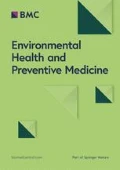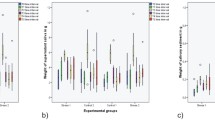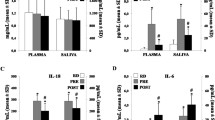Abstract
To evaluate secretory immunoglobulin A (slgA) in saliva as an immunological stress marker, we reviewed the literature on slgA and its variation caused by psychosocial factors. Among the studies on the effect of academic stress on slgA secretion, we could distinguish two kinds of stress effects: the immediate stress effect which increases slgA secretion immediately after stress, and the delayed stress effect which decreases slgA secretion several days after stress. On the basis of production and secretion mechanisms of slgA, we also speculated on possible mechanisms that underlie the variations of slgA caused by stress. Eventually, we concluded diat slgA in saliva can be a useful stress marker if we analyze the delayed stress effect on slgA separately from the immediate stress effect on slgA.
Similar content being viewed by others
References
Jemmott JB III, Locke SE. Psychosocial factors,immunologic mediation, and human susceptibility toinfectious diseases: How much do we7/4/2008 6:14:09 PM know? Psychol Bull 1984; 95: 78–108.
Kiecolt-Glaser JK, Glase R. Stress and immune function inhumans. In: Ader R, Felton D, Cohen E., eds. Psychoneuroimmunology, 2nd ed. Orlando: Academic Press,Inc., 1991: 849–67.
Tomasi TB. Structure and function of mucosal antibodies. Annu Rev Med 1970; 21: 281–98.
Hanson LA, Ahlstedt S, Andersson B, et al. Mucosalimmunity. Ann N Y Acad Sci 1983; 409: 1–21.
Mestecky J, Russell MW, Jackson S, Brown TA. The humanIgA system: A reassessment. Clin Immunol Immunopathol 1986; 40: 105–14.
Brandtzaeg P, Bjerke K, Kett K, et al. Production andsecretion of immunoglobulins in the gastrointestinal tract. Ann Allergy 1987; 59: 21–39.
Mestecky J, Czerkinsky C, Russell MW, et al. Induction andmolecular properties of secretory and serum IgA antibodiesspecific for environmental antigens. Ann Allergy 1987; 59: 54–9.
Mestecky J, McGhee JR. Immunoglobulin A (IgA):Molecular and cellular interactions involved in IgAbiosynthesis and immune response. Adv Immunol 1987; 40:153–245.
Childers NK, Bruce MG, McGhee JR. Molecularmechanisms of immunoglobulin A defense. Annu Rev Microbiol 1989; 43: 503–36.
Aroeti B, Casanova J, Okamoto C, et al. Polymericimmunoglobulin receptor. Int Rev Cytol 1992; 137: 157–68.
Mostov KE. Transepithelial transport of immunoglobulins. Annu Rev Immunol 1994; 12: 63–84.
Tomasi TB. Introduction:an overview of the mucosal system.In: Orga PL, Strober W, Mestecky J, McGhee JR, Lamm ME, Bienenstock J, eds. Handbook of mucosal immunology.San Diego: Academic Press, Inc., 1994: 3–8.
Armstrong SJ, Dimmock NJ. Neutralization of influenzavirus by low concentrations of hemagglutinin-specificpolymeric immunoglobulin A inhibits viral fusion activity,but activation of the ribonucleoprotein is also inhibited. J Virol 1992; 66: 3823–32.
Mazanec MB, Kaetzel CS, Lamm ME, Fletcher D, Nedrud JG. Intracellular neutralization of virus by immunoglobulinA antibodies. Proc Natl Acad Sci USA 1992; 89: 6901–5.
Silbart LK, Keren DF. Reduction of intestinal carcinogenabsorption by carcinogen-specific secretory immunity.Science 1989; 243: 1462–4.
Kaetzel CS, Robinson JK, Chintalacharuvu KR, Vaerman J-P, Lamm ME. The polymeric immunoglobulin receptor(secretory component) mediates transport of immunecomplexes across epithelial cells: A local defense function forIgA. Proc Nati Acad Sci USA 1991; 88: 8796–800.
Jemmott JB, McClelland DC. Secretory IgA as a measure ofresistance to infectious disease: comments of Stone, Cox, Valdimarsdottir, and Neale. Behav Med 1989; 15: 63–71.
Gleeson M, Cripps AW, Clancy RL, Hensley MJ, Henry RJ,Wlodarczyk JH. The significance of transient mucosal IgAdeficiency on the development of asthma and atopy inchildren. In: Mestecky J, et al. eds. Advances in MucosalImmunology. New York: Plenum Press, 1995: 861–4.
Drummond PD, Hewson-Bower B. Increased psychosocialstress and decreased mucosal immunity in children withrecurrent upper respiratory tract infection. J Psychosom Res 1997; 43 (3): 271–8.
Jemmott JB III, Borysenko JZ, Borysenko M, et al. Academic stress, power motivation, and decrease in secretionrate of salivary secretory immunoglobulin A. Lancet 1983; 1:1400–2.
Jemmott JB III, Magloire K. Academic stress, social support,and secretory immunoglobulin A. J Pers Soc Psychol 1988; 55 (5): 803–10.
Mouton C, Fillion L, Tawadros E, Tessier R. Salivary IgA isa weak stress marker. Behav Med 1989; 15 (4): 179–85.
Deinzer R, Schuller N. Dynamics of stress-related decrease ofsalivary immunoglobulin A (slgA): Relationship tosymptoms of the common cold and studying behavior.Behav Med 1998; 23: 161–9.
Kiecolt-Glaser JK, Garner W, Speicher C, Penn GM,Holliday J, Glaser R. Psychosocial modifiers ofimmunocompetence in medical students. Psychosom Med 1984; 46(1): 7–14.
McClelland DC, Ross G, Patel V. The effect of an academicexamination on salivary norepinephrine andimmunoglobulin levels. J Human Stress 1985; 11: 52–9.
Evans P, Bristow M, Hucklebridge F, Clow A, Pang F-Y. Stress, arousal, Cortisol and secretory immunoglobulin A instudents undergoing assessment. Br J Clin Psychol 1994; 33:575–6.
Spangler G. Psychological and physiological responses duringan exam and their relation to personality characteristics. Psychoneuroendocrinology 1997; 22 (6): 423–41.
Fame M, Boni P, Gnugnoli D, Corallo A. The effect of dailyhassles on salivary IgA: experimental evidence. Boll Soc Ital Biol Sper 1992; 68: 409–12.
Evans P, Bristow M, Hucklebridge F, Clow A, Walters N. The relationship between secretory immunity, mood, andlife events. Br J Clin Psychol 1993; 32: 227–36.
Stone AA, Neale JM, Cox DS, Napoli A, Vldimarsdottir H,Kennedy-Moore E. Daily events are associated with asecretory immune response to an oral antigen in men. Health Psychol 1994; 13:440–6.
Zeier H, Brauchli P, Joller-Jemelka HI. Effects of workdemands on immunoglobulin A and cortisol in air trafficcontrollers. Biol Psychol 1996; 42: 413–23.
Dillon KM, and Minchoff B. Positive emotional states andenhancement of the immune system. Int J Psychiatry Med 1985–86; 15(1): 13–8.
Green RG, Green M. Relaxation increases salivaryimmunoglobulin A. Psychol Rep 1987; 61: 623–9.
Jasnoski ML, Kugler J. Relaxation, imagery, andneuroimmuno-modulation. Ann N Y Acad Sci 1987; 496: 722–30.
Green ML, Green RG, Santoro W. Daily relaxation modifiesserum and salivary immunoglobulins and psychophysiologicsymptom severity. Biofeedback Self Regul 1988; 13 (3): 187–99.
Olness K, Culbert T, Uden D. Self-regulation of salivaryimmunoglobulin A by children. Pediatrics 1989; 83 (1): 66–71.
Croitoru K, Bienenstock J. Characteristics and functions ofmucosa-associated lymphoid tissue. In: Orga PL, Strober W,Mestecky J, McGhee JR, Lamm ME, Bienenstock J, eds. Handbook of mucosal immunology. San Diego: AcademicPress, Inc., 1994: 141–9.
MacLennan ICM, Gray D. Antigen-driven selection ofvirgin and memory B cells. Immunol Rev 1986; No91: 61–85.
Friedman BK, Greenberg B. Effect of extracorporeal cesiumirradiation on secretory and serum immunoglobulins. J DentRes 1975; 54; special issue A: 68.
Herbert TB, Cohen S. Stress and immunity in humans: ameta-analytic review. Psychosom Med 1993; 55: 364–79.
van Rood YR, Bogaards M, Goulmy E, van Houwelingen HC. The effects of stress and relaxation on the in vitroimmune response in man: a meta-analytic study. J Behav Med 1993; 16: 163–81.
Stratakis CA, Chrousos GP. Neuroendocrinology andpathophysiology of the stress system. Ann N Y Acad Sci 1995; 771: 1–18.
Cauna N, Cauna D. Association of nerve fibers and plasmacells in abnormal human nasal respiratory mucosa. Ann Otol Rhinol Laryngol 1974; 83: 347–59.
Stead RH. Innervation of mucosal immune cells in thegastrointestinal tract. Reg Immunol 1992; 4 (2): 91–9.
Kawano M, Tanaka H, Ishikawa M, et al. Interleukin-Iaccelerates autocrine growth of myeloma cells throughinterleukin-6 in human myeloma. Blood 1989; 73: 2145–8.
Bergui L, Schena M, Gaidano G, Riva M, Caligaris-Cappio F. Interleukin 3 and interleukin 6 synergistically promote theproliferation and differentiation of malignant plasma cellprecursors in murine multiple myeloma. J Exp Med 1989; 170:613–8.
Anderson KC, Jones RM, Morimoto C, Leavitt P, Barut BA. Response patterns of purified myeloma cells tohematopoietic growth factors. Blood 1989; 73: 1915–24.
Taylor CW, Grogan TM, Salmon SE. Effects of interleukin-4 on the in vitro growth of human lymphoid and plasma cellneoplasms. Blood 1990; 75: 1114–8.
Kawano M, Hirano T, Matusda T, et al. Autocrinegeneration and requirement of BSF-2/IL-6 for humanmultiple myelomas. Nature 1988; 332: 83–5.
Kimata H, Sherr EH, Saxon A. Human natural killer (NK)cells produce a late-acting B-cell differentiation activity. J Clin Immunol 1988; 8: 381–9.
Kimata H, Yoshida A, Ishioka C, Mikawa H. Erythropoietinenhances immunoglobulin production and proliferation byhuman plasma cells in a serum-free medium. Clin ImmunolImmunopathol 1991; 59: 495–501.
Kimata H, Yoshida A, Ishioka C, Mikawa H. Nerve growthfactor inhibits immunoglobulin production by but notproliferation of human plasma cell lines. Clin ImmunolImmunopathol 1991; 60: 145–51.
Kimata H, Yoshida A. Differential effect of growth hormoneand insulin-like growth factor-I, insulin-like growth factor-II,and insulin on Ig production and growth in human plasmacells. Blood 1994; 83 (6): 1569–74.
Sollid LM, Kvale D, Brandtzaeg P, Markussen G, Thorsby E. Interferon-gamma enhances expression of secretorycomponent, the epithelial receptor for polymericimmunoglobulins. J Immunol 1987; 138: 4303–6.
Phillips JO, Everson MP, Moldoveanu Z, Lue C, Mestecky J. Synergistic effect of IL-4 and IFN-gamma on theexpression of polymeric Ig receptor (secretory component)and IgA binding by human epithelial cells. J Immunol 1990;145: 1740–4.
Kvale D, Lovhaug D, Sollid LM, Brandtzaeg P. Tumornecrosis factor-alpha up-regulates expression of secretorycomponent, the epithelial receptor for polymeric Ig. J Immunol 1988; 140: 3086–9.
Kelleher RS, Hann LE, Edwards JA, Sullivan DA. Endocrine, neural, and immune control of secretorycomponent output by lacrimal gland acinar cells. J Immunol 1991; 146 (10): 3405–12.
Lambert RW, Gao J, Kelleher RS, Wickman LA, Sullivan DA. Neural, endocrine and immune regulation of secretorycomponent production by lacrimal gland acinar cells. In:Mestecky J, et al. eds. Advances in Mucosal Immunology. New York: Plenum Press, 1995: 221–4.
Sullivan DA, Wira CR. Variations in free secretorycomponent levels in mucosal secretions of the rat. J Immunol 1983; 130 (3): 1330–5.
Sullivan DA, Kelleher RS, Vaerman J-P, Hann LE. Androgen regulation of secretory component synthesis bylacrimal gland acinar cells in vitro. J Immunol 1990; 145(12): 4238–44.
Stone AA, Cox DS, Valdimarsdottir H, Neale JM. Secretory IgA as a measure of immunocompetence. J Human Stress 1987; 13: 136–40.
Brandtzaeg P. Human secretory immunoglobulins VII,concentrations of parotid IgA and other secretory proteins inrelation to the rate of flow and duration of secretorystimulus. Arch Oral Biol 1971; 16: 1295–310.
Guhad FA, Hau J. Salivary IgA as a marker of social stress inrats. Neurosci Lett 1996; 216: 137–40.
Miletic ID, Schiffman SS, Miletic VD, Sattely-Miller EA. Salivary IgA secretion rate in young and elderly persons.Physiol Behav 1996; 60 (1): 243–8.




